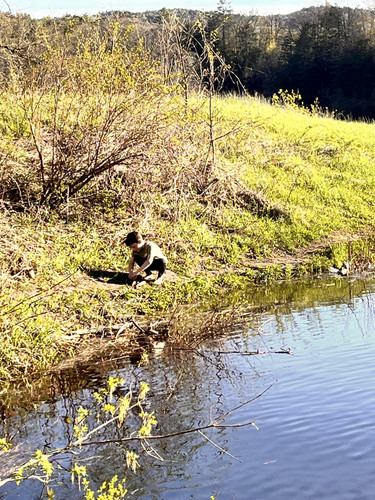- Welcome to FinsandFur.net Forums.
Recent posts
#3
Non Hunting/Fishing Photos / Geo magnetic huh?
Last post by FinsnFur - Yesterday at 10:20:34 PMHey @Todd Rahm, you got any pics of this Geo Magna Kahoopa Doo thats going on right now?
I got a friend in Crivitz (northern Wisconsin) thats sending me pics from his driveway, and they look like the northern lights.
You have to be getting some pics from your friends in AK.
I got a friend in Crivitz (northern Wisconsin) thats sending me pics from his driveway, and they look like the northern lights.
You have to be getting some pics from your friends in AK.

#4
The Tailgate / Today in history 5-10
Last post by remrogers - Yesterday at 10:42:21 AM1869
May 10
Transcontinental railroad completed, unifying United States
On May 10, 1869, the presidents of the Union Pacific and Central Pacific railroads meet in Promontory, Utah, and drive a ceremonial last spike into a rail line that connects their railroads. This made transcontinental railroad travel possible for the first time in U.S. history. No longer would western-bound travelers need to take the long and dangerous journey by wagon train.
Since at least 1832, both Eastern and frontier statesmen realized a need to connect the two coasts. It was not until 1853, though, that Congress appropriated funds to survey several routes for the transcontinental railroad. The actual building of the railroad would have to wait even longer, as North-South tensions prevented Congress from reaching an agreement on where the line would begin.
One year into the Civil War, a Republican-controlled Congress passed the Pacific Railroad Act (1862), guaranteeing public land grants and loans to the two railroads it chose to build the transcontinental line, the Union Pacific and the Central Pacific. With these in hand, the railroads began work in 1866 from Omaha and Sacramento, forging a northern route across the country. In their eagerness for land, the two lines built right past each other, and the final meeting place had to be renegotiated.
Harsh winters, staggering summer heat and the lawless, rough-and-tumble conditions of newly settled western towns made conditions for the Union Pacific laborers—mainly Civil War veterans of Irish descent—miserable. The overwhelmingly immigrant Chinese work force of the Central Pacific also had its fair share of problems, including brutal 12-hour work days laying tracks over the Sierra Nevada Mountains (they also received lower wages than their white counterparts). On more than one occasion, whole crews would be lost to avalanches, or mishaps with explosives would leave several dead.
For all the adversity they suffered, the Union Pacific and Central Pacific workers were able to finish the railroad–laying nearly 2,000 miles of track–by 1869, ahead of schedule and under budget. Journeys that had taken months by wagon train or weeks by boat now took only days. Their work had an immediate impact: The years following the construction of the railway were years of rapid growth and expansion for the United States, due in large part to the speed and ease of travel that the railroad provided.
May 10
Transcontinental railroad completed, unifying United States
On May 10, 1869, the presidents of the Union Pacific and Central Pacific railroads meet in Promontory, Utah, and drive a ceremonial last spike into a rail line that connects their railroads. This made transcontinental railroad travel possible for the first time in U.S. history. No longer would western-bound travelers need to take the long and dangerous journey by wagon train.
Since at least 1832, both Eastern and frontier statesmen realized a need to connect the two coasts. It was not until 1853, though, that Congress appropriated funds to survey several routes for the transcontinental railroad. The actual building of the railroad would have to wait even longer, as North-South tensions prevented Congress from reaching an agreement on where the line would begin.
One year into the Civil War, a Republican-controlled Congress passed the Pacific Railroad Act (1862), guaranteeing public land grants and loans to the two railroads it chose to build the transcontinental line, the Union Pacific and the Central Pacific. With these in hand, the railroads began work in 1866 from Omaha and Sacramento, forging a northern route across the country. In their eagerness for land, the two lines built right past each other, and the final meeting place had to be renegotiated.
Harsh winters, staggering summer heat and the lawless, rough-and-tumble conditions of newly settled western towns made conditions for the Union Pacific laborers—mainly Civil War veterans of Irish descent—miserable. The overwhelmingly immigrant Chinese work force of the Central Pacific also had its fair share of problems, including brutal 12-hour work days laying tracks over the Sierra Nevada Mountains (they also received lower wages than their white counterparts). On more than one occasion, whole crews would be lost to avalanches, or mishaps with explosives would leave several dead.
For all the adversity they suffered, the Union Pacific and Central Pacific workers were able to finish the railroad–laying nearly 2,000 miles of track–by 1869, ahead of schedule and under budget. Journeys that had taken months by wagon train or weeks by boat now took only days. Their work had an immediate impact: The years following the construction of the railway were years of rapid growth and expansion for the United States, due in large part to the speed and ease of travel that the railroad provided.
#5
The Tailgate / Re: S'posed to get my biggest ...
Last post by HaMeR - May 09, 2024, 02:49:27 PMQuote from: Okanagan on April 09, 2024, 11:17:57 AMQuote from: HaMeR on April 07, 2024, 09:39:53 AMAlways loved your stories.
Not sure I like the past tense of your compliment!
An having my best morning since surgery, FWIW. Don't feel good but don't feel as bad as usual. I suspect it is the deflated lungs that are making me so tired for so long, getting them back to full function. Talking on the phone tires me more than a half hour walk, and I'm guessing because it makes the lungs work more to talk.
I'm Sorry. I understand what you're saying. I didn't mean it to be that way. I know you're gonna be alright thru everything. I truly am Sorry. Get Well Soon Ok!!


#6
The Tailgate / Today in history 5-9
Last post by remrogers - May 09, 2024, 09:16:56 AM1964
May 9
An unlikely challenger ends the Beatles' reign atop the U.S. pop charts
On May 9, 1964, the great Louis Armstrong, age 63, broke the Beatles' stranglehold on the U.S. pop charts with the #1 hit "Hello Dolly."
Following the ascension of "I Want to Hold Your Hand" to #1 in early February, the Beatles held the top spot on the Billboard Hot 100 for three and a half solid months—longer than any popular artist before or since. Over the course of those months, the Fab Four earned three consecutive #1 singles (a record); held all five spots in the top five in early April (a record); and had a total of 14 songs in the Billboard Hot 100 in mid-April (yet another record). But just when it seemed that no homegrown act would ever stand up to the British invaders, one of the least likely American stars imaginable proved himself equal to the task: jazz trumpeter Louis Armstrong.
In a way, it was entirely appropriate that a titan such as Louis Armstrong would be the artist to end the reign of the first foreign group ever to take over the American pop scene. It can be argued, after all, that Armstrong bears more responsibility for shaping the course of 20th-century American music than Elvis Presley and Frank Sinatra combined. Louis Armstrong became one of jazz music's first individual superstars as a young trumpet player in the 1920s and 30s, but more than that, he revolutionized jazz itself by turning it into an individual improvisational art form.
The recordings Armstrong made with his Hot Five and Hot Seven combos between 1925 and 1927 are widely credited with creating much of the foundation for the future of jazz and blues performance and, by extension, of rock and roll. Armstrong's own statement that "if it hadn't been for jazz, there wouldn't be no rock and roll," was effectively endorsed by the Rock and Roll Hall of Fame, which inducted Armstrong as an "early influencer" in 1990.
Of course, it wasn't Louis Armstrong the young revolutionary, but Louis Armstrong the late-career light entertainer who knocked the Beatles from the top of the pops. By the early 1960s, Armstrong's most important and influential work was already behind him, yet his famous charisma and ebullient personality were still enough to lift a show tune like "Hello Dolly" to the #1 spot on the pop charts—and over the Beatles—on this day in 1964.
May 9
An unlikely challenger ends the Beatles' reign atop the U.S. pop charts
On May 9, 1964, the great Louis Armstrong, age 63, broke the Beatles' stranglehold on the U.S. pop charts with the #1 hit "Hello Dolly."
Following the ascension of "I Want to Hold Your Hand" to #1 in early February, the Beatles held the top spot on the Billboard Hot 100 for three and a half solid months—longer than any popular artist before or since. Over the course of those months, the Fab Four earned three consecutive #1 singles (a record); held all five spots in the top five in early April (a record); and had a total of 14 songs in the Billboard Hot 100 in mid-April (yet another record). But just when it seemed that no homegrown act would ever stand up to the British invaders, one of the least likely American stars imaginable proved himself equal to the task: jazz trumpeter Louis Armstrong.
In a way, it was entirely appropriate that a titan such as Louis Armstrong would be the artist to end the reign of the first foreign group ever to take over the American pop scene. It can be argued, after all, that Armstrong bears more responsibility for shaping the course of 20th-century American music than Elvis Presley and Frank Sinatra combined. Louis Armstrong became one of jazz music's first individual superstars as a young trumpet player in the 1920s and 30s, but more than that, he revolutionized jazz itself by turning it into an individual improvisational art form.
The recordings Armstrong made with his Hot Five and Hot Seven combos between 1925 and 1927 are widely credited with creating much of the foundation for the future of jazz and blues performance and, by extension, of rock and roll. Armstrong's own statement that "if it hadn't been for jazz, there wouldn't be no rock and roll," was effectively endorsed by the Rock and Roll Hall of Fame, which inducted Armstrong as an "early influencer" in 1990.
Of course, it wasn't Louis Armstrong the young revolutionary, but Louis Armstrong the late-career light entertainer who knocked the Beatles from the top of the pops. By the early 1960s, Armstrong's most important and influential work was already behind him, yet his famous charisma and ebullient personality were still enough to lift a show tune like "Hello Dolly" to the #1 spot on the pop charts—and over the Beatles—on this day in 1964.
#7
The Tailgate / Today in history 5-8
Last post by remrogers - May 08, 2024, 10:34:28 AM1902
May 8
Mount Pelée begins to erupt, burying Caribbean city
On May 8, 1902, Martinique's Mount Pelée begins the deadliest volcanic eruption of the 20th century. By the following day, the city of Saint Pierre, which some called the Paris of the Caribbean, was virtually wiped off the map.
Mount Pelée, the name meaning bald in French, was a 4,500-foot mountain on the north side of the Caribbean island of Martinique. On April 2, 1902, new steam vents were spotted on the peak, which overlooked the port city of Saint Pierre. Three weeks later, tremors were felt on the island and Mount Pelée belched up a cloud of ash.
Caught up in the midst of an important election, residents of Saint Pierre failed to heed the mountain's warnings and evacuate. The nearby residents mistakenly believed that the only danger from the volcano was lava flow and that if lava started to flow, they would have plenty of time to flee to safety. In fact, some people came from outside the city to view the action, even after ash from the eruption began to block roads.
On May 7, on the nearby island of St. Vincent, Mt. Soufrière erupted, killing more than 1,500 people. At the same time, activity on Mount Pelée increased dramatically and the blasts grew significantly stronger. Overnight, there were several strong tremors and a cloud of gas with a temperature of more than 3,000 degrees Fahrenheit spilled out of the mountain. Finally, a tremendous blast in the early morning hours sent an avalanche of boiling ash down the side of the mountain at 300 miles per hour.
The city of Saint Pierre was buried within minutes and virtually everyone—an estimate 27,000 souls—died instantly. There were only two reported survivors. One was a prisoner held in an underground cell who, according to legend, went on to be a circus attraction. In addition, 15 ships in the harbor were capsized by the eruption. One ship managed to stay afloat with half the crew surviving, although most suffered serious burns.
May 8
Mount Pelée begins to erupt, burying Caribbean city
On May 8, 1902, Martinique's Mount Pelée begins the deadliest volcanic eruption of the 20th century. By the following day, the city of Saint Pierre, which some called the Paris of the Caribbean, was virtually wiped off the map.
Mount Pelée, the name meaning bald in French, was a 4,500-foot mountain on the north side of the Caribbean island of Martinique. On April 2, 1902, new steam vents were spotted on the peak, which overlooked the port city of Saint Pierre. Three weeks later, tremors were felt on the island and Mount Pelée belched up a cloud of ash.
Caught up in the midst of an important election, residents of Saint Pierre failed to heed the mountain's warnings and evacuate. The nearby residents mistakenly believed that the only danger from the volcano was lava flow and that if lava started to flow, they would have plenty of time to flee to safety. In fact, some people came from outside the city to view the action, even after ash from the eruption began to block roads.
On May 7, on the nearby island of St. Vincent, Mt. Soufrière erupted, killing more than 1,500 people. At the same time, activity on Mount Pelée increased dramatically and the blasts grew significantly stronger. Overnight, there were several strong tremors and a cloud of gas with a temperature of more than 3,000 degrees Fahrenheit spilled out of the mountain. Finally, a tremendous blast in the early morning hours sent an avalanche of boiling ash down the side of the mountain at 300 miles per hour.
The city of Saint Pierre was buried within minutes and virtually everyone—an estimate 27,000 souls—died instantly. There were only two reported survivors. One was a prisoner held in an underground cell who, according to legend, went on to be a circus attraction. In addition, 15 ships in the harbor were capsized by the eruption. One ship managed to stay afloat with half the crew surviving, although most suffered serious burns.
#9
Fishing Photos / Re: Fish On !
Last post by Hawks Feather - May 08, 2024, 07:01:55 AMThose smiles tell the whole story. They are having fun!






